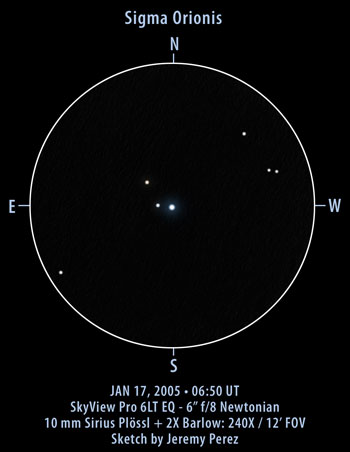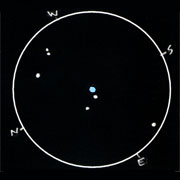
October 12, 2006: To help provide a consistent style for my double star sketches, the above sketch is a digital update to the original sketch.

Observation Notes:
A neat multiple star area. There was a triple star at center with a blue component on the west side. The northeast component almost looked orangeish by comparison, but it’s really white. Another double is on the west edge of the view.
| Subject | Sigma Orionis (48 Ori / STF 762) |
| Classification | Multiple Star |
| Position | Orion [RA: 05:39 / Dec: -02:36]* |
| Separation* | 12.9″ / 43″ |
| Magnitudes* | 4.0 / 7.5 / 6.5 |
| Position Angle* | 84° / 61° |
| Date/Time | 01/16/05 – 11:50 PM |
| Observing Loc. | Flagstaff, AZ – Home |
| Instrument | Orion SVP 6LT Reflector (150 mm dia./1200 mm F/L) |
| Eyepieces/Mag. | 10 mm + 2X Barlow (240X) |
| Conditions | Patchy high clouds, cool (34°F), 1st quarter Moon |
| Seeing | 5/10 |
| Transparency | Mag 4.9 NELM |
*Based on published data.
I really love your website and have lots of fun making reference to your double star observations. I am currently finishing up observations for the Astro League 100 binary List. A lot of times my estimation of north is incorrect. I use a Meade 12mm Astrometric illuminted eyepiece and do the drift method. Sometimes I have to subtract/add 90º or 180º. There doesn’t seem to be any rule to follow.
Hi Stephen,
The basics I use: with tracking turned off, stars will drift west (PA 270°). Whether North is clockwise or counterclockwise will depend on the telescope. A refractor with a mirror diagonal (1 reflection) will put north clockwise from west. A Newtonian (2 reflections) will put north counter-clockwise from west. The best way to find out is to let stars drift and mark that point west, and then nudge the scope northward–stars will enter on the north side of the field. Once you note the relationship, you will automatically know north any time you mark the westward drift in your drawing/notes.
Here is a link to a protractor setup I put together to help me keep things straight when measuring with the astrometric eyepiece: Measuring Double Stars.
Let me know if that was what you were looking for.
Clear skies,
Jeremy